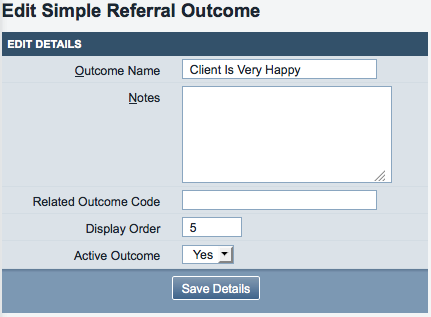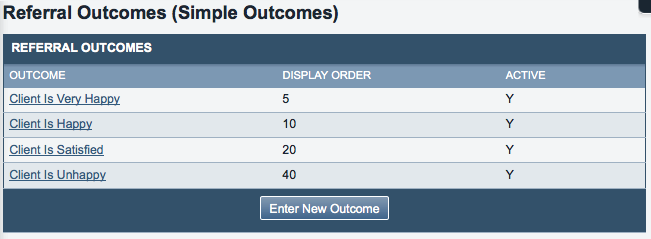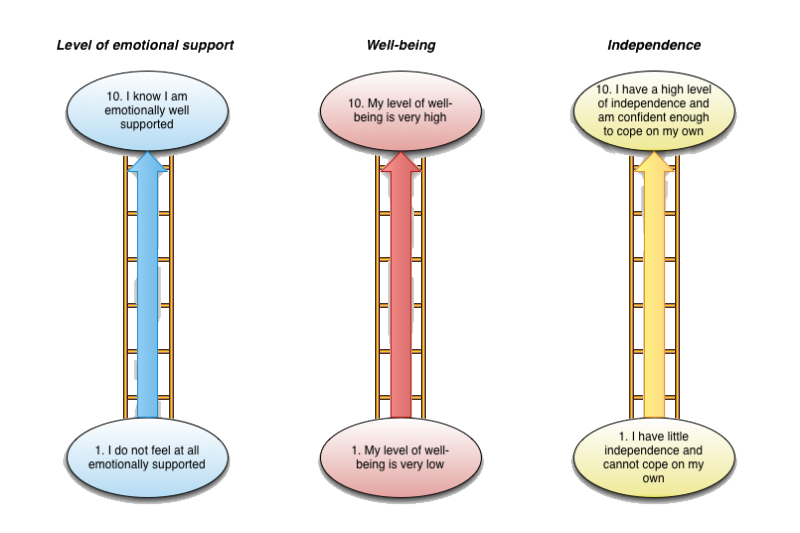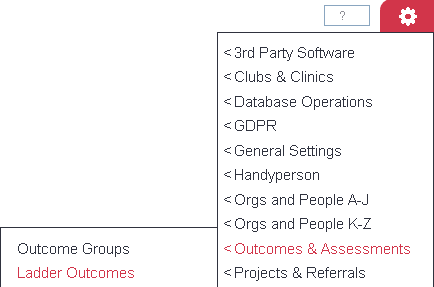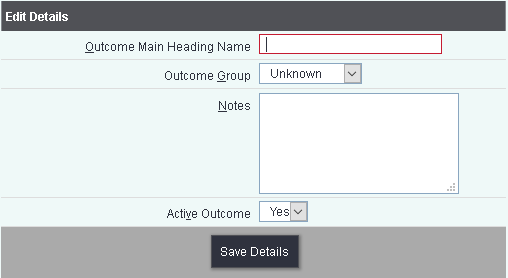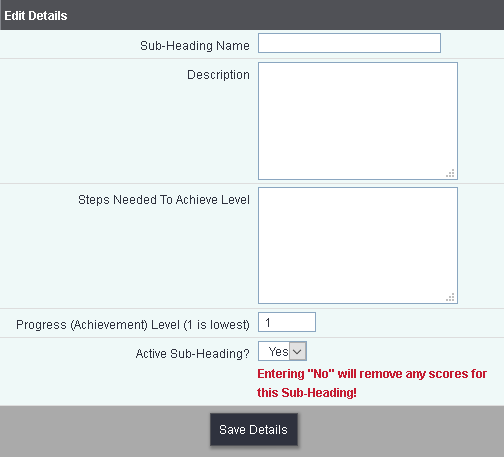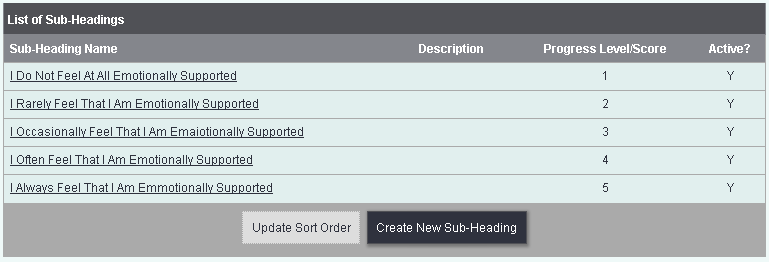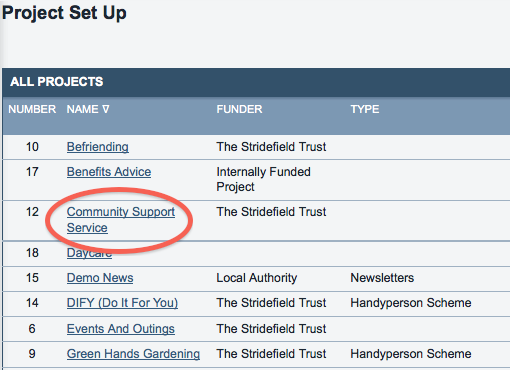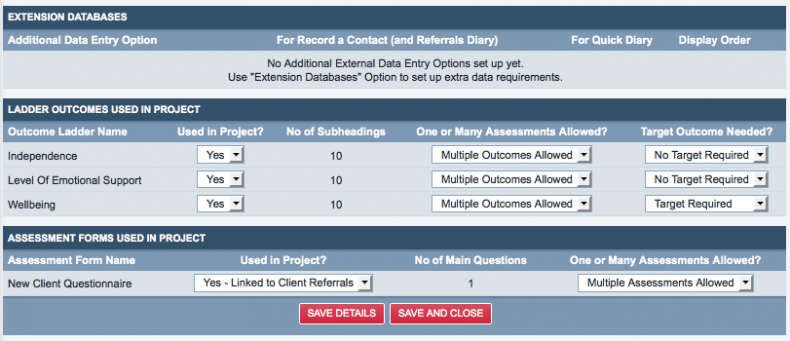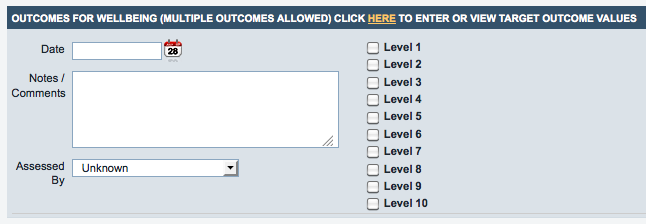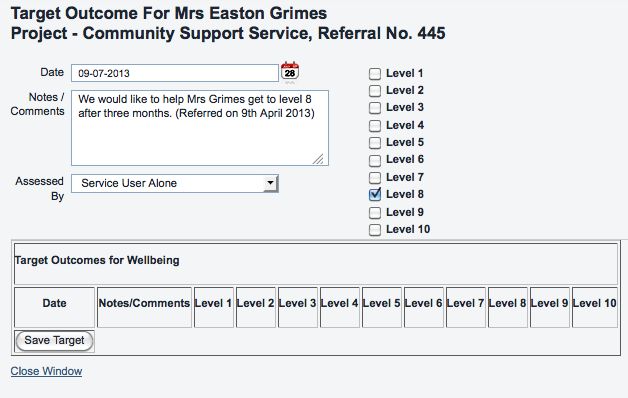Difference between revisions of "Outcomes (Administrator guide)"
(→Ladder Outcomes) |
(→Ladder Outcomes) |
||
| Line 131: | Line 131: | ||
| − | [[File:A_outcomes_13.png|border]] | + | [[File:A_outcomes_13.png|790px|border]] |
Revision as of 10:27, 10 April 2013
Measuring outcomes is one of the most popular reasons for implementing Charitylog. Charitylog's Reports Section allows detailed reports on all activity logged, and this goes most of the way to telling you what you need to know about your organisation's activity. These are usually called "hard" outcomes, which can be measured in numbers. However, there will probably still be other things you need to measure - for example, whether clients are happy with the services you provide, which is usually called a "soft" outcome. You might also want to measure even more intangible things; for example, whether a client's self-confidence has improved because of the services your organisation provides.
Outcomes make this possible. Charitylog has two kinds of outcome measurement available - Simple Diary Outcomes and Ladder Outcomes.
Outcomes are for measurements on scales. If you want to measure more complex or qualitative questions, this can also be done using assessments.
Contents
Referral Outcomes (Simple)
Simple Diary Outcomes are on their way to becoming a legacy feature, and may be deprecated in a future version. We advise that new systems are set up to use Ladder Outcomes instead. In some cases, classification codes may also suit.
Simple Diary Outcomes are intended to capture one-off measures, at the end of each referral. They are linked to referrals - one entry per referral. They are available to all projects, which means that they are best suited to broad, non-specific measures which can apply to every project. For example, consider this sliding scale which measures how happy the client is with the service they have received today...
A simple measure like this can be mirrored using Simple Diary Outcomes.
Simple Diary Outcomes are accessed from the "Referral Outcomes (Simple)" menu item, which is found in the "Outcomes" submenu.
Clicking this menu item will take you to a display of the simple outcomes set up on your system, if there are any. To add an outcome, click the "Enter New Outcome" button.
You can now enter the first outcome, adding a display order, notes and an associated reporting code if you need one.
When all the outcomes from the chart above are set up, the outcome display might look like this.
These outcomes are now ready to use.
When to use Simple Diary Outcomes
Though basic, Simple Diary Outcomes can be a very effective measure of your activity. The key thing when using Simple Diary Outcomes is that staff need to know when to use them. If there is any ambiguity about whether outcomes should be entered or not, users will often tend towards not using them, simply because it's easier! Therefore, make sure that staff are in no doubt as to when they need to fill in an outcome.
Sometimes, Simple Diary Outcomes can work well on a temporary basis. For example, a particular project can fill in a Simple Diary Outcome on every referral for one month. This will give you a snapshot of the project's effectiveness without the relevant staff needing to fill in an outcome on every referral for the entire year.
Remember that Simple Diary Outcomes are system-wide, and are intended to take one measure across your whole organisation. For more complex and Project-specific outcomes, Ladder Outcomes should be used.
Ladder Outcomes
Ladder Outcomes are the most popular outcome measurement tool with Charitylog users. Like Simple Diary Outcomes, Ladder Outcomes are linked to a referral, but Ladder Outcomes can be filled in several times on the same referral, usually with some time in between entries, so that a client's progress can be seen and measured.
Ladder Outcomes do not have to be used several times. They can be filled in only once per referral, replacing Simple Diary Outcomes but allowing Project-specific outcome entry. For this reason we recommend that Ladder Outcomes are used whenever possible, rather than Simple Diary Outcomes.
Ladder Outcomes are often used to capture several measures at once, and see progression around these measures. For example, consider this chart, which shows three scales on which you might ask a client to rate themselves.
Scales like these can easily be translated into Ladder Outcomes. You can then have the client fill in a set of these outcomes several times over a long period of time, so that you can view the client's progression.
Ladder Outcomes are set up from the "Ladder Outcomes" menu item, in the "Outcomes" submenu.
Clicking on this menu item will show you the ladder outcomes set up on your system - click the "Create New Heading" button to create a new ladder outcome.
You can now give your ladder outcome a name.
Clicking "Save Details" will return you to the display of the currently active ladder outcomes with your new one added. Click the "Edit Subheading" button to enter the stages on the outcome (in this case, from 1 to 10).
Then click "Create New Subheading" to enter the first stage, as shown.
Once complete, click "Save Details" and you will be returned to the display of subheadings. Repeat until you have all stages set up on your system with their associated scores. Note that you can add descriptions to the stages to make it easier for clients to pick the most appropriate.
The complete display of subheadings, with 10 stages, looks like this.
Making Ladder Outcomes available to Projects
Before a set of Ladder Outcomes can be filled in, it must be made available to the relevant Projects. Select the Project you need using the Project Set Up menu item - Administration > Projects and Referral Entries > Project Set Up.
Then select the Project you want to make the ladder outcomes available to, by clicking on the name of the Project (Community Support Service in the demo screenshot).
This will take you to the Project Details page. Select the "Additional Data Collection" tab.
Then, click the "Save and Edit Additional Data Collection" button. This will take you to the following screen.
You can now specify which of the Ladder Outcomes you have set up on your system are to be used in this project. The screenshot shows that all three sets of Ladder Outcomes are going to be available to referrals in the Community Support Service project, with multiple assessments allowed for each one. There are also two extra columns which you can enter information in via the drop-down boxes;
One or Many Assessments Allowed?
Here you can choose whether the assessment can only be done once, or several times. Setting the drop-down to "Multiple Outcomes Allowed" will allow users to fill in the ladder outcomes as many times as required per referral.
Target Outcome Needed?
Here you can choose whether to allow outcome targets to be set. See below for information about Outcome Targets.
Entering Ladder Outcomes on a referral
Entering Ladder Outcomes is dealt with in the end user manual; Ladder Outcomes.
Adding a target to a Ladder Outcome
If allowed in the "Additional Data Collection" tab of the Project Set Up screen, users can add a target to a ladder outcome for a particular client. This is accessed from the Ladder Outcome Entry screen (which can be accessed directly from the Record a Contact screen, or by clicking the relevant link in the "Summary" tab of the Client Details screen).
This will take you to the following screen. You can now enter the date by which you wish the target to be reached, any notes to accompany this, and who should assess the person.
Setting a target for a Ladder Outcome does not relate to a particular action in Charitylog. Rather, it will appear on the Ladder Outcome Target Comparison Report.

